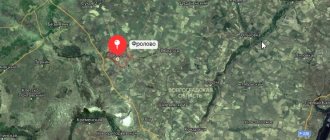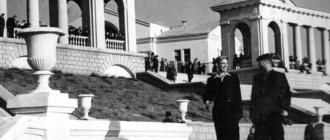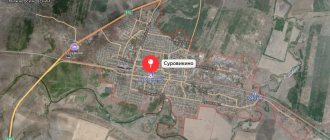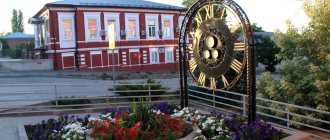There are cities in Russia that are familiar to everyone from school. Without these cities and towns, the fate of Russia could have developed according to a completely different scenario. Each of them is important and has deep historical significance. In the south of Russia, in the Rostov region in particular, such a great patriarch is the ancient city of Azov.
This land, where the Don flows into the Sea of Azov, has been a tasty morsel for many peoples and great powers for more than 2,000 years. The owner of Azov controlled access to the southern seas and was the master in the Azov region. The city remembers the era of commercial flourishing, Persian caravans, bloody battles and the valor of Russian soldiers beyond scientific explanation. And even though it has now lost its military significance, having turned into a deep Russian province, everyone who comes to the Don land should visit Azov. Read about what this city is famous for and how to get to Azov in this post.
A little history
You can’t tell about Azov in a few words. His story is so complex and dramatic that it could serve as the basis for a multi-hour lecture. You can read more fully about the history of Azov in the following posts. Today I will try to tell you the most interesting things.
The first settlements on the site of Azov appeared in the 1st century. BC. They were founded by Meotian farmers who actively traded with the Greek city of Tanais.
In the 3rd century. nomads destroyed settlements, taking possession of beautiful pastures under the warm southern sun. Sarmatians and Huns, Scythians and Khazars, Pechenegs and Polovtsians settled here.
In Russian chronicles, the settlement was first mentioned in 1067. In this year, the city of Azak was founded on the site of the death of the Polovtsian Khan Azup (probably the name of the settlement is associated with the name of the khan).
In the 12th century. The Venetian trading post of Tana was located near the banks of the Don. This place was extremely important in trade between East and West. It was a transit point on the Great Silk Road. Having learned about this, the Tatars also wanted to own land on the Don. In a matter of years, a populous trading city of the Golden Horde grew up next to the Italian colony. It retained its former name – Azak.
Trading cities of Azak and Tana
Azak and Tana were so close to each other that many considered them to be one settlement. In order to somehow protect themselves from the Tatars, the Italians begged Uzbek Khan to allow them to surround the Tana quarters with a wall, for which they agreed to pay tribute and trade duties.
In 1395, the thriving trade center was completely destroyed by Tamerlane's troops. He never achieved more than his former greatness.
In the 15th century, Turks appeared in the place of Azak and Tana. They completely destroyed the cities, establishing their fortress here - Azov.
Turkish fortress Azov. Reconstruction
From a large trading city, Azov turned into a defensive Turkish fortification in southern Russia. The Cossacks who settled on the Don were greatly annoyed by the nearby Turkish fortress.
In 1637, at a meeting of the Military Circle in the Monastic Town, a decision was made to attack Azov. After 2 months, the enemy was driven out of the territory. The Turkish fortress passed to the Don Army.
Cossacks march to Azov
In 1638, the Crimean Khan tried to take possession of the fortified outpost, but his small army was defeated. The Turks decided to regain the fortress at any cost. In 1641, having gathered an army of 250 thousand, they approached Azov, where at that time there were only 5,000 Cossacks. “The ground trembled from the number of enemies, and the Don overflowed its banks,” eyewitnesses recalled. For 93 days and nights the Cherkasy Cossacks valiantly defended the Russian bastion. This was a great battle, which went down in history as the “Azov Siege.”
Azov siege seat
The completely exhausted Cossacks finally knocked out the enemy, and the Ottomans were forced to flee. But after 2 years, having received no support from the capital, the Cossacks left dilapidated Azov and returned home to the town of Monastyrsky. The Turks took advantage of this and again occupied the Azov fortress, destroying the Cossack monastery town.
A new battle for the southern seas began with the coming to power of Peter I. In the 17th century. Azov found itself at the center of historical events of the Russian Empire. The Azov campaigns, the formation of the Azov fleet, the Russian-Turkish wars... He finally joined Russia in 1774.
Azov campaigns of Peter I
By the beginning of the 19th century. Russia's borders moved to Kuban, and the city of Azov lost its military significance. Gradually it became an ordinary provincial town. But in the middle of the 19th century. The Crimean War recalled the possibility of organizing a military fortress in Azov. Military warehouses, artillery batteries were located here, and fortification work was carried out. The ships of the Russian flotilla kept a constant watch in the port. The war ended and dull provincial life began again in Azov. He appeared in newspaper reports only in 1901, when, close to him, the Russian physicist A. Popov designed the first civilian radio station in Russia.
And then there was a civil war and German occupation... The fate of many Russian cities in the twentieth century. look like a carbon copy. The establishment of Soviet power, the rapid growth of industry, the Great Patriotic War... The German occupation lasted seven months. Every second house was destroyed.
In the post-war years, industry developed rapidly in the city, enterprises and housing were built. In 1953, after the construction of the Volga-Don Canal, the port of Azov became a port of five seas, which to this day retains its international significance.
The importance of the city in the modern world
Modern Azov is a small city with an area of 67.5 km2. At the same time, it is a developed industrial center. Here are the Azov Shipyard, engineering, chemical, construction, light industry and trade enterprises, including a baby food enterprise, the largest in Europe.
Azov organizations produce:
- metalworking equipment;
- special equipment;
- Construction Materials;
- transformer substations;
- optical products;
- metal structures;
- medical devices;
- paint and varnish products;
- agricultural machinery;
- equipment for polymer processing.
The city's large international port is designed to deliver goods from north to south and work with cargo flows in the Mediterranean and Southern European directions. This is the main transport hub connecting the waterways of Russia with the Mediterranean Sea. The enterprise processes about 2 million tons of cargo annually at 11 berths.
Azov today
Modern Azov is a quiet, very green and cozy city with a population of just over 80 thousand people. The industrial zone is located outside the residential areas, and the center has become a great place for walking and studying history.
Modern city of Azov
Along the banks of the Don, the ramparts of the Azov fortress, a ditch, and the Alekseevsky Gate have been preserved. The Powder Magazine, a monument to the military engineering art of the 18th century, as well as a small fragment of the wall of the Italian trading post of Tana, and a large port have been preserved here. But, perhaps, the brightest pearl in this necklace remains the Azov Museum of Local Lore, which allows you to look at Azov with completely different eyes, imbued with the spirit of respectful respect for the glorious history of this incredible southern city.
Geography
To the west of the settlement lies the line of demarcation of forces in Donbass[5][6] (see Second Minsk Agreement).
Neighboring settlements by country of the world
Under the control of the Ukrainian Armed Forces
SW
: Shirokino
Z
: Vodyanoe (in the “buffer zone”)
Under the control of the DPR
NW
: Kominternovo (in the “buffer zone”)
WITH
: Zaichenko
NE
: Vesyoloye, Mitkovo-Kachkari
SE
: Unnamed
YU
: Leninskoe, Sakhanka
How to get to Azov?
The close proximity of Azov to Rostov-on-Don (only 37 km) makes it an easily accessible destination for any traveler who comes to the Don land. By car this journey will take no more than 40-50 minutes. GPS coordinates: 47.1, 39.416667 (47° 6′ 0″ N, 39° 25′ 0″ E).
If you don’t have a car, you can get to Azov by bus, minibus or commuter train. Minibuses and minibuses depart from Rostov-on-Don: from the Main Bus Station (ticket office at platform No. 1) every half hour; from Station Square at intervals of 10-15 minutes. You will have to spend a little over an hour on the way.
The commuter train to Azov does not depart as often as buses and minibuses. More complete information about the movement of electric trains can be obtained at the ticket office of the Prigorodny railway station or Yandex.Schedule.
Recreation and entertainment
Azov, whose attractions attract Russian and foreign travelers, provides city guests with many opportunities for recreation and entertainment. The city has billiard clubs, karaoke clubs, entertainment centers, bars, cafes and restaurants. You can dance and watch shows in the Tortuga tavern, located on the banks of the Don.
The Krepostnoy Val restaurant is famous for its cozy atmosphere, relaxed atmosphere and good service.
The theatrical life of the city is represented by the folk children's theater "Gorodok" and the theater "KUL-SHOW", offering viewers interesting performances, shows, television projects and films.
Of interest to anglers is fishing on the Don, which is popular among connoisseurs and is rich in fish that live there. Lucky fishermen can catch pike perch weighing up to 7 kg. Catfish is considered a good catch. On the territory of the city there are green areas: a park of culture and recreation and the Pearl of Azov Park. The river station invites tourists on river walks and excursions on motor ships.
Every year in the first days of August, a festival of military history clubs takes place in Azov, which lasts several days. The main event of the festival is a theatrical reconstruction of the Cossacks sitting during the siege on the historical site of their feat - the ramparts.
Don't miss the most popular article in the section: Metro Nizhny Novgorod. Diagram, map, description.
Temples of the Azov Icon of the Mother of God
Azov “distinguished himself” not only by giving its name to the sea. He also distinguished himself by having his own city icon, and what is more surprising, in the city there are 2 churches with the same name, dedicated to the Azov Icon of the Mother of God!
The red brick so-called “regimental” church, located on the street. Makarovsky, 25B, is not particularly remarkable in architectural terms. But it is notable for the fact that it belongs to the Russian Orthodox Church.
Orthodox Church of the Azov Icon of the Mother of God
The second church, belonging to the so-called “Russian True Orthodox Church,” which has nothing in common with the Russian Orthodox Church, is unique in its structure. It has 5 differently designed domes and a very unusual open bell tower.
Construction of the church has been going on since 1995. Outwardly, it looks quite complete.
Temple of the Azov Icon of the Mother of God (RTOC)
What to bring as souvenirs
Travelers bring as souvenirs from Azov:
- products with marine and military themes;
- figurines, dishes, clothes with maritime symbols;
- goods associated with Cossack paraphernalia: weapons, hats, cups;
- Azov wine;
- smoked fish;
- shell products.
Tourists who have visited Azov enthusiastically talk about the sights, shady parks and cozy cafes of the city, the panorama of which opens up when visiting the observation deck.
Author: Alekseeva Irina
Article design: Oleg Lozinsky
Museums
Azov museums preserve and enhance the cultural and historical attractions of the city. Tourists most often visit such museums.
Museum-reserve, founded in 1917. The museum's storage facilities contain more than 400 thousand exhibition items. The museum is located on Moskovskaya Street, 38/40. The complex is located in the Administration building, erected at the end of the 19th century. This building with a turret is a city architectural monument. The museum is open from Tuesday to Sunday from 10.00 to 18.00.
The museum contains:
- Rich paleontological collection . The ancient exhibits date back several million years.
- A large archaeological collection , which presents the culture of the Don peoples in various historical eras.
The museum houses exhibitions:
- Fortress of Azov from Peter I to Barclay de Tolly . Exhibits at the exhibition tell about Russian conquests in the south of Russia, the creation of the country's first navy, Russia's battles against Turkey, access to the Black Sea.
- Nature of the lower Don . The exhibition consists of a single complex consisting of two sections. The first section presents forest plantations, floodplain forest and forest fauna. Also presented in this section is the Ataman Forestry, founded more than 140 years ago. The second section is devoted to the ichthyofauna of the Lower Don basin, the flora and fauna of the Don delta.
The exhibition is equipped with multimedia interactive complexes in the form of touch panels. Exposition of the Azov region during the Great Patriotic War. The exhibition consists of 6 sections. The exhibition displays military uniforms, documents and awards of soldiers and officers of the Red Army. An additional interactive exhibit is located on the touch screen.
Museum of R. L. Samoilovich, located on Leningradskaya Street, 46. Opening hours: Tuesday, Thursday, Saturday from 10.00 to 18.00. The museum is located in the house in which Rudolf Lazarevich was born and raised. Here the young man graduated from four classes of the men's gymnasium.
In his former room, an interior from the late 19th – early 20th centuries was created with original photographs and personal belongings. The museum is open from 10:00 to 18:00 every day except Monday.
Exhibition hall "Patron", which is located at Leningradskaya street, 86a. The hall receives visitors daily from 9.00 to 17.00. Personal and collective modern and classical exhibitions are held on its premises.
The exhibition hall also hosts thematic classes for preschoolers and schoolchildren. The children's methodical school is visited by more than 1,500 people annually.











